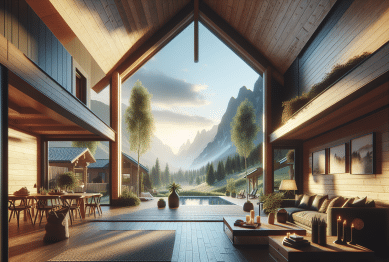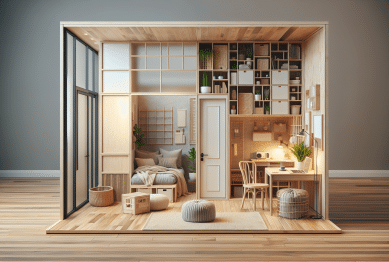Curious about the tiny home lifestyle and how people make it work? Dive into the realities, benefits, and practical secrets behind tiny house living. This article unpacks clever space solutions, real-life challenges, and surprising perks, blending popular keyphrases and expert insights for those exploring minimalist housing.
The Allure of Tiny Home Living
Tiny home living has captured widespread attention among people seeking more affordable, flexible, and sustainable housing options. Whether motivated by a desire to declutter, reduce expenses, or embrace a more environmentally conscious lifestyle, individuals are increasingly drawn to the versatility that tiny homes offer. There’s a unique sense of freedom that comes from knowing everything you need can be contained within a few hundred square feet, sparking curiosity about design possibilities and daily comfort. Downsizing may seem intimidating at first, but many discover that it fosters intentional living and removes much of the stress that comes with maintaining larger houses.
The movement has inspired communities across the world to rethink traditional housing models. Minimalist design, smart storage, and personalized touches characterize many tiny homes, with layouts carefully optimized to fit everyday needs. For some, this lifestyle means the ability to travel with their home, while for others, it’s about finding a permanent place within a tiny house village. This increasing demand has led to new innovations in mobile homes, eco-friendly building materials, and energy-efficient systems. Stories of people thriving in compact spaces frequently challenge what many believe about comfort and space requirements.
Tech-savvy homeowners often turn to composting toilets, solar panels, and rainwater harvesting systems to round out their tiny home experience. With a focus on sustainability, eco-friendly living practices go hand-in-hand with smart space planning. Inspiration is abundant, and many find that tiny homes provide more than just a roof—they offer a meaningful shift toward simplified, intentional living. The allure goes far beyond size. It’s about a lifestyle centered on quality over quantity, with unexpected bonuses like lower utility costs and a greater connection to local communities (Source: https://www.nahb.org).
Clever Design That Makes Small Spaces Feel Large
Designing for tiny living requires creative thinking and flexible furniture. Multipurpose spaces serve as the cornerstone of effective small home layouts, with convertible sofas, Murphy beds, and foldaway desks offering practical solutions to maximize functionality. Storage often takes the form of hidden compartments, built-in cabinetry, and under-floor drawers, allowing residents to make the most of every available inch. There’s an art to making compact areas feel airy and open, much of which relies on thoughtful color schemes, natural lighting, and strategic use of mirrors.
Open shelving, vertical gardens, and sliding doors further contribute to the perception of spaciousness. Even the smallest kitchens in tiny homes can be organized to support gourmet cooking, thanks to add-ons like pull-out pantries and tall storage units. Well-planned layouts prevent the feeling of clutter, while lofted sleeping spaces add privacy without sacrificing square footage. These design choices encourage efficiency and make daily routines simpler, bringing joy to daily living through practical beauty.
Innovative tiny home builders often incorporate smart technology, which helps control temperature, security, and lighting from the palm of one’s hand. By using compact appliances and modular pieces, these homes provide the comfort and convenience many expect from much larger houses. For those curious about the creative side of sustainable living, tiny home design can be an inspiring playground. Custom and DIY builds allow homeowners to tailor their environment, making each detail tell a personal story (Source: https://www.huduser.gov).
Financial Surprises: Affordability and Costs
One of the biggest draws of tiny home living is perceived affordability, but the reality can be more nuanced. While initial builds or purchases can cost less than traditional homes, expenses must be weighed alongside ongoing costs like land, utilities, and permits. Many have found that tiny homes offer a pathway to reducing monthly bills, as they often require less energy to heat, cool, and maintain. For first-time homeowners, the prospect of smaller mortgages—or none at all—can be incredibly appealing, putting financial goals within reach in ways not possible in larger properties.
However, there are important financial factors to remember. Insurance for tiny homes may differ from standard home insurance policies, especially if the home is on wheels or considered a recreational vehicle. Land zoning laws also affect where tiny homes can be placed, sometimes requiring additional investments in site preparation. It’s useful to explore local building codes and acknowledge practicalities such as the cost of water hookups or off-grid solutions like composting toilets and solar energy installations. While many residents report substantial savings, careful budgeting and research help avoid unexpected expenses.
Financing a tiny home looks different from traditional housing, as many lenders have specific requirements for tiny properties. Some people choose personal loans, while others save to build over time or join tiny house communities with communal resources and land access. Community living can sometimes provide bulk savings on utilities or shared infrastructure. The lower overall cost of living remains a major benefit, supporting goals like debt reduction, travel, or early retirement (Source: https://www.consumerfinance.gov).
Unexpected Challenges and Hidden Rewards
Tiny home living is not without its hurdles. Adapting to limited square footage can take significant adjustment for individuals and families used to larger spaces. Downsizing personal belongings is often an emotional and logistical challenge, requiring thoughtful sorting and a willingness to let go. Shared spaces call for strong communication and flexibility, particularly in multi-person households. Practical concerns—like moisture control, pest management, or limited storage—create ongoing maintenance demands that aren’t always apparent at first glance.
Despite these challenges, many people discover unexpected advantages that outweigh initial struggles. The opportunity to develop tighter community bonds, participate in shared gardens, or support local businesses is a highlight for many. A slower pace of life, greater appreciation for the outdoors, and increased focus on experiences over possessions are commonly noted rewards. The process of simplifying one’s lifestyle, though sometimes uncomfortable, often leads to higher life satisfaction and a stronger sense of autonomy.
Stories abound of residents finding peace, purpose, and joy after making the transition. The ability to relocate or change scenery by moving a tiny home appeals to those with restless spirits or evolving priorities. Living tiny can be a catalyst for personal growth, prompting individuals to reevaluate what truly matters and shift their relationship with consumption. While every lifestyle has trade-offs, the hidden rewards of tiny living are revealed in the daily details and long-term outcomes (Source: https://www.apa.org).
Eco-Friendly Living: Tiny Homes as a Sustainable Choice
Tiny homes naturally lend themselves to eco-friendly practices, as their size limits the environmental footprint and encourages resource conservation. Many are built with sustainable materials or repurposed elements, and occupants often take pride in reducing wastage. Solar power, rainwater harvesting, and composting toilets are frequently used to create energy and water independence. By living smaller, residents lower their carbon emissions and support biodiversity efforts from their own backyards or surrounding environments.
In contrast to resource-intensive conventional homes, tiny homes require less energy to heat and cool. Smart insulation methods, double-glazed windows, and efficient appliances further minimize consumption. Some communities implement collective waste management or food production, such as shared gardens or chicken coops, highlighting how sustainable lifestyle changes can be woven into the tiny home movement. Many find that living small helps clarify what resources are essential, making conservation less of a sacrifice and more of a mindful choice.
The link between sustainable housing and well-being becomes evident as more people experience improved quality of life in eco-friendly tiny homes. Reduced energy bills and water use free up finances for other pursuits, while the daily habits formed support broader environmental goals. As urban and rural communities seek ways to address housing shortages and climate change, tiny homes serve as working examples of how design and consciousness can shape a more resilient future (Source: https://www.epa.gov).
Finding Your Fit: Who Thrives in Tiny Homes?
No one-size solution exists in the tiny home world. Singles, couples, retirees, remote workers, and creative professionals all find reasons to embrace this lifestyle. Some crave adventure, while others prioritize financial freedom or simplicity. The ability to personalize every inch makes tiny homes especially popular among those seeking to express their values through their living space. Community-minded individuals may prefer shared villages, while travelers might opt for mobile models that double as campers or off-grid cabins.
Adaptable work-life routines are a major draw, as the rise of remote employment pairs well with flexible housing. Artists, entrepreneurs, and telecommuters use tiny homes as both residences and creative studios or offices. For people prioritizing mental health or seeking less stressful environments, tiny home living can provide the quiet and privacy not always available in busier urban apartments. Intergenerational living and co-housing projects also see successful integration of tiny units, offering independence while staying connected to family or friends.
Health and wellness considerations play a vital role. People with mobility needs sometimes find custom tiny homes more accessible, as layouts can be tailored to limit stairs or minimize obstacles. The ability to design for unique health needs provides peace of mind and enhances quality of life for many residents. The community aspect, whether in rural clusters or urban backyards, keeps tiny home living vibrant, diverse, and adaptable to evolving lifestyle needs (Source: https://williamangliss.edu.au).
References
1. National Association of Home Builders. (n.d.). Tiny Houses. Retrieved from https://www.nahb.org
2. U.S. Department of Housing and Urban Development. (n.d.). Alternative Housing Models. Retrieved from https://www.huduser.gov
3. Consumer Financial Protection Bureau. (n.d.). Considering a Tiny Home? Retrieved from https://www.consumerfinance.gov
4. American Psychological Association. (n.d.). The Psychology Behind Downsizing. Retrieved from https://www.apa.org
5. U.S. Environmental Protection Agency. (n.d.). Green Building. Retrieved from https://www.epa.gov
6. William Angliss Institute. (n.d.). Tiny House Living. Retrieved from https://williamangliss.edu.au









